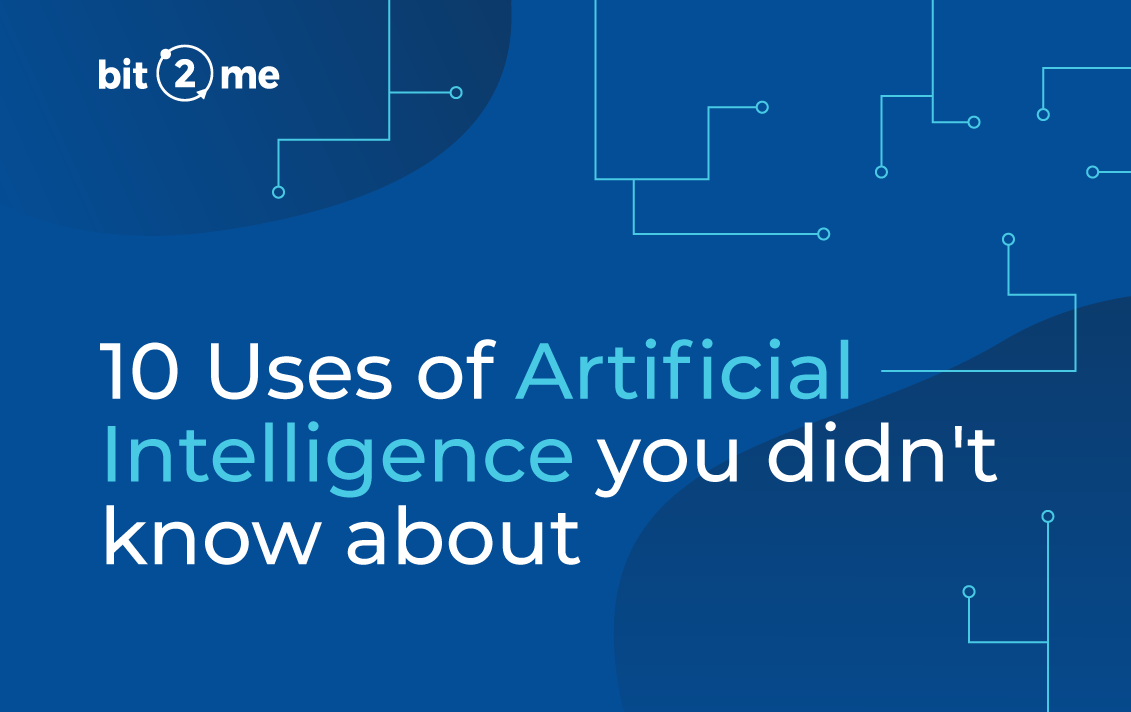If you like technology and you are up to date with the latest news, we are sure that lately, you keep hearing about Artificial Intelligence (AI), Machine Learning, artificial neural networks, and all this kind of stuff.
AI can be implemented in virtually any process, and it makes life and business much easier.
This technology has many applications and allows us to do things that were unthinkable just a few years ago; from chatbots that help you book a hotel room to apps that recommend what movie or series to watch next.
AI is changing the way we interact with the digital world. But all this is just the beginning, get ready to discover some examples of AI that you are using in your daily life without even realizing it!
What Is Artificial Intelligence?
But wait, before we dive right into all these examples of AI that you are using every day without even realizing it, let’s find out what we are talking about, what is artificial intelligence?
To get a clear idea of what artificial intelligence is, let’s climb into the time machine and travel back to the 50s. At that time, a scientist and mathematician named Alan Turing asked himself, “Can machines think?“.
This simple question would end up revolutionizing technology and the world. Following this question, Turing wrote the article Computing Machinery and Intelligence and created the Turing Test, laying the foundations for artificial intelligence as AIs aim to answer Turing’s question in the affirmative and aspire to replicate human intelligence.
And the best definition would be: Artificial Intelligence is the simulation of human intelligence processes by computer systems. These processes include learning, reasoning, and the ability to self-correct, iterating from data collected during learning to improve themselves.
This Is How You Use Artificial Intelligence in Your Daily Life Without Realizing It
When you think of Artificial Intelligence, TV supercomputers like Skynet or HAL 9000 probably come to mind. If you are of a certain age, you might remember Deep Blue, the supercomputer that beat world chess champion Gary Kasparov in the 90s.
But the truth is that today Artificial Intelligence is everywhere and not precisely as supercomputers, but as cell phones, smart speakers, and all those kinds of devices that we use every day and that make our lives easier.
Have you ever thought about how you are using artificial intelligence in your daily life without realizing it?
Gmail and Your Spam-Free Inbox
Gmail, Google’s email platform, uses artificial intelligence and machine learning to manage incoming emails and filter unwanted emails or spam.
This system can learn through examples and identify spam, and send it to a special folder. It also learns based on your actions, for example, if you always delete emails from a certain address, the system will label them as spam after a while. In this way, Gmail protects our devices from cyberattacks and malware.
Gmail also has a feature that mimics the way you write, to answer emails for you. This feature is called Smart Reply and is a smart reply model that analyzes your emails to “predict” how you would respond to an email.
Personalized Recommendations
Surely more than once you have entered Amazon thinking about buying something and you have just found what you were looking for on the front page.
Well, these predictions are made by complex artificial intelligence and machine learning algorithms, which analyze your shopping habits on the platform to try to predict what you are going to buy next… And you know what? They work like a charm. According to Amazon, a third of the platform’s sales are made through these recommendations.
Amazon uses Machine Learning to learn from your consumer habits and establish viewing or purchasing patterns and trends. In fact, these algorithms have become so sophisticated that they even know what you want before you do… 😱
And so do streaming platforms such as Spotify, YouTube, or Netflix. In such cases, they analyze the content you usually consume, and through machine learning and predictive algorithms, they recommend other content that you will like.
With AI You Will Never Get Lost
How long has it been since you last used a Michelin guide? And how long since you bought a road map? It sure has been a lot, and Google Maps is to blame for that.
Google’s map and navigation app is one of the most comprehensive out there, and that is thanks to Artificial Intelligence. Maps uses algorithms to suggest the fastest and most efficient routes depending on the means of transport you use.
Also, if you have been using the tool for a few years, you will have noticed how much it has improved when it comes to guiding us. Again, thanks are due to Artificial Intelligence and Machine Learning, which have allowed the application’s indications to be more and more precise.
But this is not the only way in which AI helps us drive. Today, almost all vehicles are equipped with some form of artificial intelligence: park assist, lane change control, signal recognition, or emergency braking systems… These are all examples of AI in the automotive world.
Self-Driving Cars
Although it is not yet common to see self-driving cars on our roads, some companies, such as Tesla, are working to make it happen soon.
Through Artificial Intelligence, the cars of the future will incorporate automatic navigation systems, with predictive capabilities that will allow them to take faster routes, with less traffic, and avoid traffic accidents. These cars will have communication systems that will send signals to each other to know where each car is at all times and avoid accidents.
On the other hand, a less futuristic use of AI in automobiles is the system developed by Tesla to continuously update the software of its vehicles through the cloud.
Automatic Translations
Another application of Artificial Intelligence in our day-to-day life is translation and languages. Thanks to Neural Processing Units (NPU) and optimized Machine Learning processes, some devices offer automatic translation applications even locally (without the need to access the Internet or the cloud to translate correctly).
Translation applications, such as Google Translate or DeepL, use artificial intelligence and Machine Learning to offer increasingly refined translations, thanks to machine learning algorithms.
Although there is still a long way to go, these programs use statistical analysis of patterns of millions of documents already translated to continuously improve their processes.
Filters for Instagram and TikTok
Have you used a filter on TikTok to become your favorite anime character? Have you used the AI Greenscreen filter to create images using words? Well, all that is possible thanks to Artificial Intelligence.
Most of the filters we use on social media, especially those that add effects or enhance our appearance in photos, use Artificial Intelligence, so they can differentiate the different parts of our faces.
In this sense, filters are based on techniques developed within a field of AI called computer vision, which focuses on making devices able to “see”, i.e., capable of extracting useful information from the real world from the images they capture.
To do this, machines are “fed” millions of images. For example, if you want an AI to distinguish between a nose and an eyebrow, you train it with millions of images of human faces.
Your Best Photos
Have you taken a selfie lately? Well, if you have, you should know that you have used Artificial Intelligence without knowing it. That’s right, your smartphone camera uses AI systems to improve the photos you take.
Have you used portrait mode? Your camera can focus on the person and blur the background thanks to AI, which can differentiate the person from the surroundings thanks to computer vision, just like in the previous example.
This way, mobile cameras can recognize scenes or learn which light and focus settings are ideal to get the best photo in each situation.
Voice Assistants
We’re sure you already knew this one.
Your smartphone uses artificial intelligence in many different ways. Siri, Alexa, and Google Assistant are some tools widely used in our day-to-day lives, whose features are based on AI.
These assistants are also in our homes, through Amazon and Google smart speakers. In fact, a Nielsen study shows that, in the United States alone, more than 24% of households have one of these devices.
To interpret the commands, you give them and do so in the right context, the assistants use a technique called Natural Language Processing. They can respond to you appropriately and, in some cases, even carry on a conversation with you, just as a person would. In fact, some assistants can already call on your behalf to book an appointment or a table at a restaurant.
Also, if you are a software developer and use IDEs such as Visual Studio or apps such as Studio Code, you are also using an AI. In this case, artificial intelligence helps you complete code using predictive text, offering you a series of options each time you type something. It also highlights any errors in the code to facilitate their correction.
Social Media Content
If you are a social media user, you have probably heard more than once about algorithms… Similar to what we have told you about Amazon or Netflix recommendations, algorithms in social networks classify content to show you only the content they consider most suitable to your preferences.
On Twitter, due to the large volume of tweets that are posted, neural networks are used to select the most relevant or interesting content for each user, showing on their timeline only those tweets that might interest them.
Twitter also uses these neural networks to block offensive, racist or illegal content.
The same happens with Facebook, Instagram, or TikTok, as all social platforms use Artificial Intelligence algorithms to select and classify their content. This way, they only show users what they are interested in, making the network more attractive.
Customer Support
Have you tried OpenAI’s ChatGPT? Although AI chatbots are all the rage, companies have been using them for some time now.
These chats use Artificial Intelligence to answer all kinds of questions and doubts from users, with the aim of offering a technical support or help system. For example, a bank chatbot helps you manage simple procedures and requests, such as making transfers or checking your balance.
These bots use machine learning systems to refine their responses and can be used to create sales funnels and can even recommend products to customers based on their interests.
So, what do you think? Are you surprised by any of the uses we make of AI every day? We bet you are. If you want to learn more about Artificial Intelligence, its applications, regulation, and much more, do not miss our podcast, in which we dedicate an entire section to this topic.


 Author
Author


